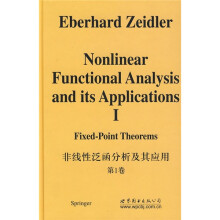Preface to the Second Corrected Printing
Preface to the First Printing
Introduction
FUNDAMENTAL FIXED-POINT PRINCIPLES
CHAPTER 1
The Banach Fixed-Point Theorem and lterative Methods
1.1. The Banach Fixed-Point Theorem
1.2. Continuous Dependence on a Parameter
1.3. The Significance of the Banach Fixed-Point Theorem
1.4. Applications to Nonlinear Equations
1.5. Accelerated Convergence and Newtons Method
1.6. The Picard-Lindel6fTheorem
1.7. The Main Theorem for Iterative Methods for Linear Operator
Equations
1.8. Applications to Systems of Linear Equations
1.9. Applications to Linear Integral Equations
CHAPTER 2
The Schauder Fixed-Point Theorem and Compactness
2.1. Extension Theorem
2.2. Retracts
2.3. The Brouwer Fixed-Point Theorem
2.4. Existence Principle for Systems of Equations
2.5. Compact Operators
2.6. The Schauder Fixed-Point Theorem
2.7. Peanos Theorem
2.8. Integral Equations with Small Parameters
2.9. Systems of Integral Equations and Semilinear Differential
Equations
2.10. A General Strategy
2.11. Existence Principle for Systems of Inequalities
APPLICATIONS OF THE FUNDAMENTAL
FIXED-POINT PRINCIPLES
CHAPTER 3
Ordinary Differential Equations in B-spaces
3.1. Integration of Vector Functions of One Real Variable t
3.2. Differentiation of Vector Functions of One Real Variable t
3.3. Generalized Picard-Lindeltf Theorem
3.4. Generalized Peano Theorem
3.5. Gronwalrs Lemma
3.6. Stability of Solutions and Existence of Periodic Solutions
3.7. Stability Theory and Plane Vector Fields, Electrical Circuits,
Limit Cycles
3.8. Perspectives
CHAPTER 4
Differential Calculus and the Implicit Function Theorem
4.1. Formal Differential Calculus
4.2. The Derivatives of Frtchet and Giteaux
4.3. Sum Rule, Chain Rule, and Product Rule
4.4. Partial Derivatives
4.5. Higher Differentials and Higher Derivatives
4.6. Generalized Taylors Theorem
4.7. The Implicit Function Theorem
4.8. Applications of the Implicit Function Theorem
4.9. Attracting and Repelling Fixed Points and Stability
4.10. Applications to Biological Equilibria
4.11. The Continuously Differentiable Dependence of the Solutions of
Ordinary Differential Equations in B-spaces on the Initial Values
and on the Parameters
4.12. The Generalized Frobenius Theorem and Total Differential
Equations
4.13. Diffeomorphisms and the Local Inverse Mapping Theorem
4.14. Proper Maps and the Global Inverse Mapping Theorem
4.15. The Surjective Implicit Function Theorem
4.16. Nonlinear Systems of Equations, Subimmersions, and the Rank
Theorem
4.17. A Look at Manifolds
4.18. Submersions and a Look at the Sard-Smale Theorem
4.19. The Parametrized Sard Theorem and Constructive Fixed-Point
Theory
CHAPTER 5
Newtons Method
5.1. A Theorem on Local Convergence
5.2. The Kantorovi Semi-Local Convergence Theorem
CHAPTER 6
Continuation with Respect to a Parameter
6.1. The Continuation Method for Linear Operators
6.2. B-spaces of H61der Continuous Functions
6.3. Applications to Linear Partial Differential Equations
6.4. Functional-Analytic Interpretation of the Existence Theorem and
its Generalizations
6.5. Applications to Semi-linear Differential Equations
6.6. The Implicit Function Theorem and the Continuation Method
6.7. Ordinary Differential Equations in B-spaces and the Continuation
Method
6.8. The Leray-Schauder Principle
6.9. Applications to Quasi-linear Elliptic Differential Equations
CHAPTER 7
Positive Operators
7. I. Ordered B-spaces
7.2. Monotone Increasing Operators
7.3. The Abstract Gronwall Lemma and its Applications to Integral
Inequalities
7.4. Supersolutions, Subsolutions, Iterative Methods, and Stability
7.5. Applications
7.6. Minorant Methods and Positive Eigensolutions
7.7. Applications
7.8. The Krein-Rutman Theorem and its Applications
7.9. Asymptotic Linear Operators
7.10. Main Theorem for Operators of Monotone Type
7.11. Application to a Heat Conduction Problem
7.12. Existence of Three Solutions
7.13. Main Theorem for Abstract Hammerstein Equations in Ordered
B-spaces
7.14. Eigensolutions of Abstract Hammerstein Equations, Bifurcation,
Stability, and the Nonlinear Krein-Rutman Theorem
7.15. Applications to Hammerstein Integral Equations
7.16. Applications to Semi-linear Elliptic Boundary-Value Problems
7.17. Application to Elliptic Equations with Nonlinear Boundary
Conditions
7.18. Applications to Boundary Initial-Value Problems for Parabolic
Differential Equations and Stability
CHAPTER 8
Analytic Bifurcation Theory
8.1. A Necessary Condition for Existence of a Bifurcation Point
8.2. Analytic Operators
8.3. An Analytic Majorant Method
8.4. Fredholm Operators
8.5. The Spectrum of Compact Linear Operators
(Riesz-Schauder Theory)
8.6. The Branching Equations of Ljapunov-Schmidt
8.7. The Main Theorem on the Generic Bifurcation From Simple Zeros
8.8. Applications to Eigenvalue Problems
8.9. Applications to Integral Equations
8.10. Application to Differential Equations
8.11. The Main Theorem on Generic Bifurcation for Multiparametric
Operator Equations——The Bunch Theorem
8.12. Main Theorem for Regular Semi-linear Equations
8.13. Parameter-Induced Oscillation
8.14. Self-Induced Oscillations and Limit Cycles
8.15. Hopf Bifurcation
8.16. The Main Theorem on Generic Bifurcation from Multiple Zeros
8.17. Stability of Bifurcation Solutions
8.18. Generic Point Bifurcation
CHAPTER 9
Fixed Points of Multivalued Maps
9.1. Generalized Banach Fixed-Point Theorem
9.2. Upper and Lower Semi-continuity of Multivalued Maps
9.3. Generalized Schauder Fixed-Point Theorem
9.4. Variational Inequalities and the Browder Fixed-Point Theorem
9.5. An Extremal Principle
9.6. The Minimax Theorem and Saddle Points
9.7. Applications in Game Theory
9.8. Selections and the Marriage Theorem
……
CHAPTER 10
CHAPTER 11
CHAPTER 12
CHAPTER 13
CHAPTER 14
CHAPTER 15
CHAPTER 16
CHAPTER 17
Index

 缺书网
缺书网 扫码进群
扫码进群




